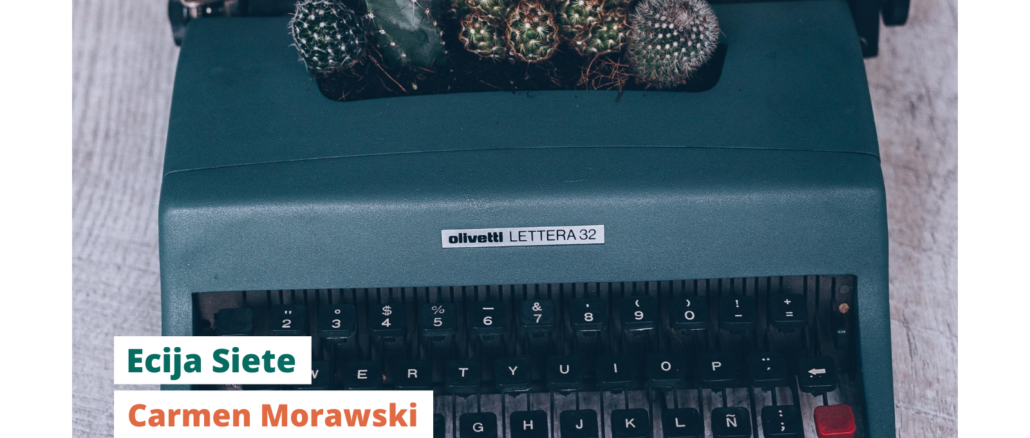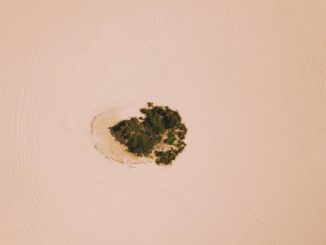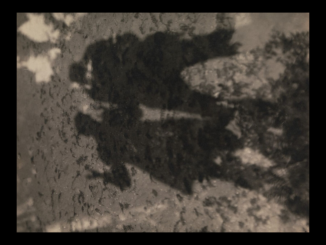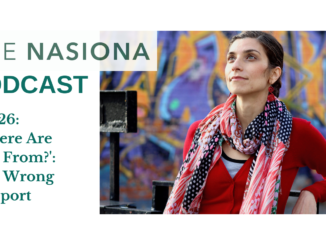
The Madrid I first knew belonged to my mother. It arrived in thin, blue-white airmail envelopes containing cards and letters, semi-transparent folios coated on both sides with what for me was Mama Carmen’s indecipherable hand. In the upper right corner, postage stamps with Franco’s image were visible beneath the ink cancellations – international ports of entry and exit – attesting to the distance the envelope had traveled. For good measure they almost always carried a Via Area / Par Avion sticker, lest any mail worker dare send them by boat; the return address: Ecija 7, 5B, Madrid, España. In those envelopes was news and gossip: Belen’s first communion, Angelito’s moto accident, Jorge’s affair … In California and far from home, my mother read it all with the insatiable hunger of distance and the forced separation of cold war political necessity. Telephone calls were expensive then. These days with the internet and Skype, my mother can spend hours each day chatting with her sister for almost nothing, but back in the sixties – Mama Carmen’s letters were the surest lifeline to Madrid and Ecija 7.
~ * ~ * ~ * ~ * ~
I have trouble with simple questions. “Where are you from?” seems benign enough, equivalent to the easy way someone will ask, “How are you?” instead of saying “Hello.” It’s a question my husband Travis answers with ease. He may say he’s from Boise, the city in which we’ve shared the same address for twenty years, or if the conversation requires more precision he might say he’s from Marsing, the Owyhee County town of six hundred inhabitants where he grew up. Like his father, an Idaho rancher, a member of the rodeo board and of the local posse, Travis is tied to Idaho. He’s a bone fide Westerner – right down to his name. In his mind there is no question of where he’s from, or where he belongs.
When people used to ask my father where he was from, he’d usually say he was from Poland. So I was surprised one day when he answered the inquiry with “Manhattan Beach” instead. At that point in his life he’d been living in California for over forty years. But our waitress had asked because of his unusual accent. As a Polish World War II veteran and exile, a trace of Scottish Brogue in his speech never ceased to mark the place he’d first learned English. It made his origins difficult to pinpoint. But no accent betrays my immigrant status, and the question, “Where are you from?” is difficult to answer. I was born in Madrid, but came to the U.S. as an infant, so I pass as a native born American, and unlike the telltale speech of other family members, my speech conceals my identity.
~ * ~ * ~ * ~ * ~
Yet thinly layered below the facade of assimilation lies the dream of a life elsewhere; my search for roots isn’t a matter of needing to know where I’m from, but of where I want to be, the rooting of the rootless. Like a tumbleweed detached from the long taproot of family origin, I seek a place to settle. I want it to reflect who I am.
I feel like an outsider wherever I go, and worse, disingenuous, appearing to be something I’m not. On paper, Boise is a nice place to live. In the historic district, most houses are sixty years old and many, closer to one hundred. They abide in a mishmash of architectural styles: Cape Cods, alongside Craftsman Bungalows and Mission style homes beside Greek Revivals. Modest two bedroom cottages tuck themselves in beside grand residences. Mature Sycamores and Maples shade the sidewalk. I like the way the houses and gardens have evolved to reflect the whims of personal taste – to make each home unique. Yet even in Boise, I’m reminded that I am floating on a small blue island in the middle of a red sea of desert and sage, cowboys and politics. Neighborhood bumper stickers may read “Coexist,” or “Blue Girl/Red State,” but they may just as easily declare “Idaho Open Carry: Go ahead, make my day!” … and I wonder what it means to be a “real” Idahoan. Still, I enjoy life on the edge of a provincial capital where a still autumn night may bring the yipping of coyotes through the window, and a ten-minute cycle can take me into an urban approximation of the European cities I seek.
~ * ~ * ~ * ~ * ~
I became aware of the flaws in my Spanish at the age of seven. It was in the taxi with Mama Carmen, en route for the first time from Barrajas airport to her Ecija flat. Sitting sidesaddle in shot gun, Mama Carmen faced the driver and shunned the restrictive seatbelt, choosing instead to prop her hand against the dashboard, a shock absorber, in the jerky stop and go of traffic. And all the while she pelted the poor man with directions, alternately telling him to slow down, and then to speed up, so that the rapid staccato of her voice and the driver’s monosyllabic responses mixed with the hum of Madrid traffic to form the urban soundtrack of my first ride to her flat. My own voice was silent. Although I could understand most of what she said, I was reluctant to speak. And no wonder. Peppered into her aphoristic commentary on the differences between Americans and Spaniards were things like “los Americanos hablan como si tuvieran una patata en la boca.” Which loosely translates to “Americans sound like they have a potato in their mouth when they speak.” Unlike the British – she said – whose speech was infinitely more refined.
Looking back, her comment probably had less to do with our American accents than with her frustration at having grandchildren who didn’t speak “Castellano” like native speakers. After all, we were her flesh and blood. And she was right, compared to her Castilian Spanish with its rapid-fire vocalization, I did sound like I had a foreign object in my mouth – at least when I tried to speak Spanish. It was early July. The exhaust of thousands of tailpipes combined with the dazzling afternoon sun so that my head was dull, adrift in shock. I kept my mouth shut. The driver let us out at the entrance to a tall apartment building and we took the elevator to the fifth floor.
We had just entered my grandmother’s flat when I ventured a timid “Abuela?” She turned and looked down at me to answer, “Ni abuela, ni abuelita! Yo soy Mama Carmen!” My grandmother smiled and feigned the stoop of an old lady with a cane. No, she didn’t look like a grandmother. In fact at that moment I wasn’t sure I liked the idea that she was my grandmother. My brothers and I had just arrived from a month-long visit with our family in Poland where I’d met my paternal grandmother for the first time. Unlike Mama Carmen, my Polish Babcia fit every detail of the fairy tale grandmothers I’d read about. She kept her hair in a small white bun and wore plain, grandmotherly clothes, even an apron; she cooked and baked on a wood stove, did her laundry on a wash board, and gathered eggs from the chickens ranging about the fenced yard; she hand-milked the only cow she had in the barn and even let me help churn our butter with a wooden churner like the ones I’d seen in movies. Each night my brothers and I would sleep together in an old fashioned feather bed, and then wake to the clip clop of horses and crowing of roosters. In the village, women drew water from a communal well and walked home balancing heavy pails of water over their shoulders. Beyond the village were fields, and where they ended, the forest began. We’d go for walks past the fields and through the forest to Ojcow and the valley below. For me, life in that 1966 Polish village under communism had been like a fairy tale come true, and I hadn’t wanted to leave.
Now I found myself looking into the face of a woman – my grandmother – who wore heavy makeup, dark red lipstick and had no real eyebrows of her own, just a thin high arch she had painted over each mascaraed eye. She wore body-hugging knit outfits with wild animal prints, a tightly cinched belt around her waist, a deep décolleté, brightly painted nails and bold jewelry. She had a mischievous smile that seemed full of trickery. And I wasn’t sure I wanted to be there.
~ * ~ * ~ * ~ * ~
Although I was wary of my Mama Carmen at first, I got used to her flamboyant dress and bossy ways. So that today, no place evokes my memories of Madrid better than her apartment at Ecija 7. The sunny courtyard balcony where she grew potted geraniums in summer, the scent of the black Magno soap in the bathroom, and the sound of her quick steps on wooden parquet flooring, all recreate that lost Madrid. So maybe this explains why, I still find myself strangely drawn to her apartment, bewitched by the ruinous emanations of a siren’s call, audible only to me.
In answer, I type the address into Google maps and in an instant the internet bridges the miles. A few more keystrokes, and my screen presents me with a bird’s eye view of my grandmother’s neighborhood – the grid of streets and pavement I walked as a child and again in my teens. I pan in closer. Details of the map come into focus, and I move the small icon, a human chess piece, onto the map. I’m in street view now, almost as if I am there. But the address isn’t quite right. Instead, I find myself on the sidewalk across the avenue that runs above Rosales Park.
This is the park where Mama Carmen’s second husband, Guillermo, would take me for “una cosita,” a little bite. We would descend to the street and walk the short distance to the outdoor café-bar above the park. “Una cosita” could be almost anything: a bag of chips or olives, a Pepsi or a café con leche, maybe an horchata or a popsicle. “Te apetece un polo?” he would ask. And there we’d sit, Guillermo with coffee and me with ice cream.
I didn’t know much about the Falange or fascism back then, just that Guillermo belonged. It wouldn’t be till after he’d died that I would hear the story about his younger brother, an eighteen-year-old medical student, shot by los rojos while trying to protect a church. La Guerra Civil. Or how Guillermo awaited the firing squad for days, only to escape when they’d tired of the killing.
Sometimes, we’d walk through the park. This is where I learned that grass in Spanish parks isn’t for children’s feet, and that children in arid countries play soccer and jump rope on smooth gravel and dirt explicitly groomed for this purpose. Green grass existed only for the eyes in Madrid, or that’s how it seemed when I was a child in the days of Generalissimo Franco.
I move the mouse and my chess piece figure reappears, as does a yellow line indicating where I can move in this game. To find my grandmother’s address, I “walk” up, and then down the street, stopping at each apartment entrance to see if I’ve found the right one. I pass one and then another and before long I see what might be the entrance to my grandmother’s building, but the doors of the portal are shut. And I feel I’ve been denied access to something that was once mine.
Upon entering Mama Carmen’s flat, you’d find yourself in a small foyer with a coat rack and umbrella stand just to the right. To get to the heart of the flat, you had to walk down a long, dark corridor illuminated only by way of the open doors along its length. Walking past a small bedroom and a bathroom – traditional service quarters – then the kitchen, until you reached the household living area. Steps along that corridor resounded throughout the flat. No one walked anonymously. Memories of my grandmother’s flat always include the sound of her hard quick steps on that worn, parquet flooring: as she returned from the market with the day’s groceries, as she walked from the dining room to the kitchen, as she made countless traverses of that wooden floor and over the years created a well worn path of high heels on soft wood.
Her steps reflected her temperament, quick, decisive, direct. My own steps on that floor spoke of a different nature: slower, tentative, reticent – not wishing to disturb or reveal my whereabouts – as though I wanted to disappear. During my summer there at sixteen, I wasn’t sure who I was yet, and wasn’t ready for my steps to reveal who I might become. My steps were unformed. Yet even a hundred years of my soft-healed steps could never imprint the floor the way Mama Carmen’s had. Her quick steps made things happen. Dinner. Conversation. Life. The rest of us were along for the ride. Like mine, Guillermo’s steps were slower, but in his case they reflected his even-tempered good nature. With his tall body and long legs he could cover the same distance with fewer steps. His marked a calm presence in the flat, while my grandmother’s were the lively spark that kept the home fire burning. Short, compact and tempestuous, she was quick to inflame but just as quick to laugh.
My mother tells me that my Mama Carmen had once been beautiful. Enough that at fifteen, she’d caught the eye of Paco Amer, a young photographer from Barcelona who married her shortly after taking a set of her portraits. In the early nineteen thirties they made a dashing couple. In one of the portraits from that time, a young Mama Carmen sports a slick roaring twenties style bob, and poses in her lipstick smile while the white fur edging of her gown’s deep décolleté maintains her breasts within respectable bounds. Beside her, my Catalan grandfather Paco looks dapper in his suit and thin mustache. Together they look fit to attend one of Gatsby’s champagne parties, that is, until the realities of the Spanish Civil War destroyed that world along with their passion.
~ * ~ * ~ * ~ * ~
The skies were grey and drizzling the morning Travis and I boarded the bus into Madrid last December. And as I observed the damp scenery through the bus window, my thoughts returned to Mama Carmen’s apartment. The lobby’s antiquated elevator came to mind, and it was as if I could still hear the creak of the black iron doors, still feel the elevator car drop in proportion to each passenger’s weight, the exterior iron gate vibrating long after the elevator had begun its tortoise ascent.
When we were kids, my brothers and I liked to race the elevator to the fifth floor, just so we could open that black iron gate for Mama Carmen. As long as we were quiet, no one seemed to mind – elevators of this vintage had a four rider limit, and more often than not, there were adults waiting to ride. We made countless trips up and down the white marble stairs that wound round that vertical path. But we almost never beat the elevator. More often, we’d reach the fifth floor, just as Mama Carmen was turning her key to open her thick wooden front door, a locking system of deadbolts and a keyed latch that opened the door with a push. The doorknob, a six-inch diameter round ornamental pull, didn’t turn at all. About hip high, and set in the center of the door, its function was to pull the door shut. I’d never seen anything like it before my first visit. But neither had I seen anything like the ornate elevator, the white marble staircase, or other such commonplaces of the Madrid of 1966.
Seated on the bus beside Travis, I plotted the trajectory for our visit. We would begin with the route I used to take the summer I stayed with my aunt and used to walk from her flat on San Francisco de Sales to Mama Carmen’s place on Ecija for lunch – right past the Ministerio del Aire – where the guards standing before the front gate always carried automatic rifles. They wore them angled low across their bodies, and slung on belts in the way a woman might hold her purse, accessories to their uniforms. It had seemed normal then, not particularly repressive or threatening. As a sixteen-year-old girl in 1973, Madrid felt like a safe place to be on my own. Walking that same route with Travis, I didn’t notice any weapons. In fact, I don’t recall if there was even a guard.
~ * ~ * ~ * ~ * ~
It was about 11 AM and the rain had steadied when Travis and I arrived at Ecija 7, so I felt lucky when the porter let us in. The lobby hadn’t changed much – the white marble staircase was just as I recalled – as was the ornate iron work of the elevator cage. But the elevator itself wasn’t the same. Brightly polished metal had replaced the antique glass doors, and even worse was the whirring sound of the new motor. It didn’t fit my memory. No doubt, the elevator was safer, but I couldn’t step in, and as Travis and I wound our way up the familiar staircase, I began to wonder why I’d come. What was I hoping to find? It was somewhere between the third and fourth floors that we stopped – when my mind knew what my heart didn’t want to admit. No one I knew could answer the door at number 5B, and as long as I didn’t knock, my vision of Mama Carmen would remain. Perhaps I shouldn’t have come at all, allowing the old elevator to continue its creaking trajectory. The visit had tainted the memory. I wondered too, if my years crisscrossing the globe didn’t mimic the elevator’s monotonous journey. It’s never-ending up and down. A back and forth of my own, that never quite arrives home.
~ * ~ * ~ * ~ * ~
Umbrellas in hand, Travis and I continued our walk through the city, tracing familiar sights and walking not unlike tourists. I was of the city but not of the city, a displaced resident on ghostly return. Relying on memory and instinct, I navigated without a map – along Rosales and on to Ferraz then past the Palacio Real. At the Royal Basilica of San Francisco el Grande, we took refuge from the rain. “Did you know?” a guide told us, “The fourth largest dome in the world!” After a bit, we continued to walk, weaving our way through the streets and shunning the Metro to savor the city by foot. We stopped in a corner bar: a caña for Travis and a tinto for me. The tapita, dos bocaditos de jamón, was on the house. But the best part of that afternoon wasn’t the church or other tourist sites. It was simply walking the streets, remembering what Madrid had been like in my teens.
~ * ~ * ~ * ~ * ~
In those days I spent most of my time with José and Tito, their parents having all but adopted me. I was sixteen and so was Tito, except that having been quite literally hit by a bus on the last day of school, it was a miracle he was alive – so pale the first time I met him – smiling in his wheelchair, surrounded by friends. As the introductions were made, I went round the room greeting each boy with a hand shake and each girl with a kiss. At sixteen and seventeen, everyone smoked openly, never failing to offer a cigarette to the others before taking one for themselves – simple good manners.
We’d wander the city in the Spanish tapas tradition, going from bar to bar. We’d sit on park benches, smoking and drinking. Sometimes José played guitar, a cigarette dangling from his lips and looking like a Spanish Dylan. We would sing Sevillanas and clap to keep time. That summer, I walked from my aunt’s flat on San Francisco de Sales to Tito’s place on Buen Successo almost every day. I knew every turn and every corner. I became an expert at threading my way through crowded streets.
So much can change from one summer to another. I was a high school graduate the following year, with a plan to recover the personal arcadia I remembered from my childhood visits to Poland. I was to begin my first year of study at the Jagiellonian University in Cracow that fall, beginning with a year of Polish language. And so it wasn’t until August that I returned to Spain. Then, as if in a dream and somewhere between Los Angeles and New York, the PanAm pilot announced that President Nixon had resigned. In Madrid, it was as if the streets had erupted in political graffiti. Franco was still alive, but black spray painted socialist party P.S.O.E.‘s and anarchist A’s decorated the streets. Tito sported a beard, and both he and José had let their hair grow shaggy. José had new friends from the university, among them a Basque girlfriend. Our conversations now centered on politics and dissident ideas – Spain was on the brink of political change. The bohemian turn in my friends not only included regular trips to Madrid’s infamous flee market, el rastro, and participation in student manifestaciones, but experimentation with drugs. No longer confined to his wheelchair, Tito returned from a trip to Morocco with a stash of high quality hashish. Now instead of meeting in the family’s front salon we crammed together into José and Tito’s bedroom, sitting on the upper and lower bunks and passing the pipe before heading out.
Over the next three years, I split my time between Poland and Spain, continuing to spend summer vacations with my friends in Madrid. Eventually, I left Europe to complete my university studies in the U.S., settling into a life in Boise. Yet life isn’t always as settled as it may seem, and my European roots continue their call.
These days, the details of those summers mix a bit in my mind, but what still lasts is the memory of times spent with José and Tito and nuestra pandilla, the friends who were like a second family. I got to know Madrid as a local, learned to take the metro, and to become one with the crowd. In the metro, a single ticket would take you anywhere in Madrid with none of the traffic above. Some metro lines sank so deeply into the earth, it felt as if you were part of the city’s bowels. Steep staircases and sometimes escalators that went down and then down some more. Graffiti and unsanctioned bulletins covered the walls. Gypsy women sitting with infants on their laps and outstretched hands. Blind lottery ticket vendors, shouting out “Para hoy!” at the entrances. The metro had a climate of its own, equally warm in summer and winter, a constant sameness in disregard of the streets above. As it surrounded my body, I found its characteristic smell strangely comforting. A blend of sweat and machines. I belonged to the city.
~ * ~ * ~ * ~ * ~

Carmen Morawski
Carmen Morawski is a multicultural writer. Her poetry translations have been published in the Hayden Ferry Review and Lunch Ticket, and her prose has been recognized by the Words and Women competition, the Bellingham Review and Mslexia. She is writing her first novel, In Solidarity, a coming-of-age narrative set in Communist-era Poland.
Featured image: Photograph by Florencia Viadana on Unsplash.


